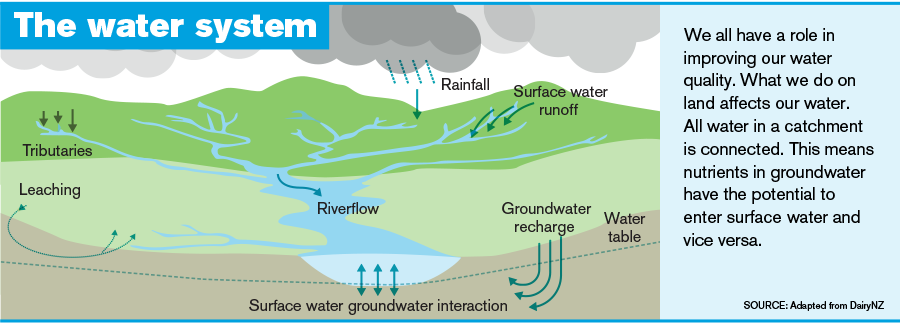For SMART Irrigation FAQs please read below. Please contact [email protected] or connect with us on Twitter or Facebook. Check back often as additional questions about irrigation will be answered here. We look forward to hearing from you!
- Why do we irrigate when it is raining?
- Irrigation systems are designed on a rotational basis. To be cost effective they apply a certain amount of water per area each day. Irrigation aims to manage the amount of moisture in the soil to ensure plant growth is not compromised during periods of low rainfall. An 'irrigation trigger' is used to do this - the moisture level in the soil has to reach a certain low before the trigger is reached. During the New Zealand summer plants use an average of 4–5mm of water a day. During peak growth they can use more than 8mm a day. This means a soil with 30mm of water available for plant growth typically has 5–8 days of optimal plant growth before requiring irrigation. Rain events during the summer are frequently only light showers of 5–10mm. Irrigators fine-tune their irrigation as best their system allows. They continue to irrigate but apply less water. When a heavy rainfall event occurs, replenishing the soil’s moisture, irrigators will switch off for a short period until the irrigation trigger is once again reached. Typically this period is 4–8 days, depending on the rotation length.
- Why do irrigators chop down trees?
- When putting in a new centre pivot irrigation system, it often means reconfiguring the farm’s tracks, fences and shelterbelts. In some cases it is possible to reduce the height of trees, hedges and shelter belts, and have the irrigator travel over the top of them. Centre pivots and linear moves are the most efficient method of applying water. They apply it very evenly and in small amounts. This allows economical irrigation of stony soils, which have low water holding ability. Centre pivots and linear moves also offer more flexibility (if rain is forecast irrigators can wait and see how much falls before irrigating).
- Why do irrigators irrigate when it’s windy?
- There are water losses arising from irrigating on a windy day, but they are minimal (less than 5%). The main side-effect of irrigating on a windy day is a change in the water distribution pattern. In this situation, the irrigation system, the strength of the wind, and the weather conditions this may create challenges for plant growth. However, not irrigating would create even greater challenges for plant growth!
- Why do irrigators irrigate during the day?
- Irrigating at night does stop evaporative losses caused by the sun. For a well-designed irrigation system, evaporative losses caused by irrigating during daylight are minimal (less than 3%). To design an irrigation system than only operates 12 hours a day would be cost prohibitive. The farm would have to double the amount of irrigators, and the water supply system would have to double its capacity. The electricity lines used would also have to double their capacity!
- Why do irrigators need long term water permits/consents?
- Irrigation is an intergenerational investment. Irrigation scheme infrastructure and farm water supply systems have life spans of well over 50 years. Irrigation systems are designed to operate for over 20 years. There is considerable capital investment required for irrigation. For example, costs of $3,000–5,000 per hectare for the farm infrastructure, and upwards of $8,000 for the scheme water supply. This investment in irrigation is increasing as the public’s water use efficiency and nutrient management expectations grow. Irrigators therefore need long-term permits/consents to give them security. This allows them to borrow money and make the investment required.
- How does New Zealand compare to Australia?
- Australia is one of the most arid countries in the world. Most irrigation occurs in the Murray Darling Basin. At one million square miles, the basin is four times the size of New Zealand (yet only 15% of Australia). Alongside the issue of size, how Australians supply water for irrigation differs hugely from the New Zealand approach. Large-scale dams are commonplace. Rivers are then used to convey the water to the irrigator or irrigation scheme. In New Zealand the majority of irrigation takes come directly from rivers. We have limited stored water, most of which is stored on-farm in small, shallow ponds. One of the challenges for New Zealand is how we are to build large scale water storage infrastructure. As communities decide they want more water in the river during the summer for native fish, plants and recreation, river water takes for irrigation will become more unreliable ( as less water is available). Water storage will be essential as it will create benefits for all New Zealanders. Another contrast is how we license water. In New Zealand, most irrigation operates under short term permit/consents (typically between 20 and 35 years). This provides limited security for farmers investing in irrigation as there is no guarantee that the permit/consent will be renewed. Australia, despite its scarcity of water, grants a license in perpetuity. This long-term right, combined with water trading, encourages water efficiency. Farmers not needing their water will trade it with those that do.
- What is ‘Virtual Water’?
- Virtual water is an award-winning theory from Professor Tony Allan of Kings College, London (for which he won the Stockholm World Water Prize in 2008). It describes the transfer of water around the globe in the form of water embedded in food and fibre. Around 90% of global water use goes into food, fibre and beverage production. “Farmers are not wasteful”, says Professor Allan. Using local resources, including water, they produce food in challenging and complex conditions.
- Is all water in a catchment connected?


